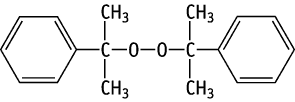

Bis(1-methyl-1-phenylethyl) peroxide was studied for oral toxicity in rats in a 28-day repeat dose toxicity test at doses of 0, 60, 200 and 600 mg/kg. No deaths were observed in any of the treatment groups in either sex. In the 200 and 600 mg/kg groups of both sexes, salivation was observed. In the 600 mg/kg group of both sexes, body weight gain was suppressed. These changes proved to be reversible after withdrawal. An increase in serum γ-GTP was observed in the 600 mg/kg group of both sexes. An increase in ALT was observed in the 600 mg/kg males.
Absolute and relative liver weights were increased in both sexes of the 600 mg/kg group and relative liver weights of were also increased in the 200 mg/kg group females. Absolute and relative thymus weights were decreased in both sexes in the 600 mg/kg group. Enlarged livers were grossly observed in the 600 mg/kg group females. Histopathologically, hypertrophy of hepatocytes was observed in the 200 and 600 mg/kg groups in both sexes. Degeneration of hepatocytes was observed in the 600 mg/kg group in both sexes. Mobilization of Kupffer cells was observed in the 600 mg/kg males. These changes proved reversible after withdrawal.
The NOEL for repeat dose toxicity is considered to be 60 mg/kg/day for both sexes.
A reverse mutation test of bis(1-methyl-1-phenylethyl) peroxide in bacteria was carried out. This substance was not mutagenic in Salmonella typhimurium TA100, TA1535, TA98, TA1537 and Escherichia coli WP2 uvrA, with or without an exogenous metabolic activation system.
Genotoxicity of bis(1-methyl-1-phenylethyl) peroxide was studied by chromosomal aberration test using cultured Chinese hamster lung (CHL/IU) cells. Bis(1-methyl-1-phenylethyl) peroxide did not induce structural chromosomal aberrations or polyploidy at any dose, with and without metabolic activation.
| Purity | : | 98.9 wt% |
| Test species/strain | : | Rat/Crj:CD(SD) |
| Test method | : | OECD Test Guideline 401 |
| Route | : | Oral(gavage) |
| Doses | : | 0, 2000 mg/kg |
| Number of animals/group | : | Males, 5; females, 5 |
| Vehicle | : | Corn oil |
| GLP | : | Yes |
Test results:
The LD50 values were more than 2000 mg/kg for both sexes.
| Purity | : | 99.9 wt% |
| Test species/strain | : | Rat/Crj:CD(SD)IGS |
| Test method | : | Guideline for 28-Day Repeated Dose Toxicity Test in Mammalian Species (Chemical Substances Control Law of Japan) |
| Route | : | Oral(gavage) |
| Doses | : | 0(vehicle), 60, 200, 600 mg/kg/day |
| Number of animals | : | Males, 5; females, 5 |
| Vehicle | : | Corn oil |
| Administration period | : | Males and females, 28 days |
| Terminal kill | : | Males and females, days 29 and 43 |
| GLP | : | Yes |
Test results:
The NOEL for repeat dose toxicity is considered to be 60 mg/kg/day for both sexes.
| Purity | : | 99.9 % |
| Test species/strains | : | Salmonella typhimurium TA100, TA1535, TA98, TA1537, Escherichia coli WP2 uvrA |
| Test method | : | Guidelines for Screening Mutagenicity Testing of Chemicals (Chemical Substances Control Law of Japan) and OECD Test Guideline 471 |
| Procedures | : | Pre-incubation method |
| Solvent | : | Dimethyl sulfoxide |
| Positive controls | : | -S9 mix; 2-(2-Furyl)-3-(5-nitro-2-furyl)acrylamide (TA100, TA98, WP2 uvrA), Sodium azide (TA1535) and
9-Aminoacridine (TA1537) +S9 mix; 2-Aminoanthracene (five strains) |
| Doses | : | -S9 mix; 0, 313, 625, 1250, 2500, 5000 μg/plate(five strains) +S9 mix; 0, 313, 625, 1250, 2500, 5000 μg/plate(five strains) |
| S9 | : | Rat liver, induced with phenobarbital and 5,6-benzoflavon |
| Plates/test | : | 3(1 for cytotoxicity test) |
| Number of replicates | : | 2(plus 1 cytotoxicity test) |
| GLP | : | Yes |
Test results:
Genetic effects:
Salmonella typhimurium TA100, TA1535, TA98, TA1537
| + | ? | - | |
| Without metabolic activation: | [ ] | [ ] | [*] |
| With metabolic activation: | [ ] | [ ] | [*] |
Escherichia coli WP2 uvrA
| + | ? | - | |
| Without metabolic activation: | [ ] | [ ] | [*] |
| With metabolic activation: | [ ] | [ ] | [*] |
| Purity | : | 99.9 % |
| Type of cell used | : | Chinese hamster lung (CHL/IU) cells |
| Test method | : | Guidelines for Screening Mutagenicity Testing of Chemicals (Chemical Substances Control Law of Japan) and OECD Test Guideline 473 |
| Solvent | : | Dimethyl sulfoxide |
| Positive controls | : | -S9 mix, Mitomycin C +S9 mix, Cyclophosphamide |
| Doses | : | -S9 mix(short-term treatment); 0, 0.00056, 0.0011, 0.0023 mg/mL +S9 mix(short-term treatment);0, 0.0094, 0.019, 0.038 mg/mL -S9 mix(continuous treatment for 24 hr); 0, 0.0050, 0.010, 0.020 mg/mL |
| S9 | : | Rat liver, induced with phenobarbital and 5,6-benzoflavone |
| Plates/test | : | 2 |
| GLP | : | Yes |
Test results:
Genotoxic effects:
| clastogenicity | polyploidy | |||||
| + | ? | - | + | ? | - | |
| Without metabolic activation: | [ ] | [ ] | [*] | [ ] | [ ] | [*] |
| With metabolic activation: | [ ] | [ ] | [*] | [ ] | [ ] | [*] |
| 1) | The tests were performed by the Biosafety Research Center, Foods, Drugs and Pesticides (An-pyo Center), 582-2 Arahama, Shioshinden, Fukude-cho, Iwata-gun, Shizuoka, 437-1213, Japan. Tel +81-538-58-1266 Fax +81-538-58-1393 |
| 2) | The tests were performed by the Hatano Research Institute, Food and Drug Safety Center, 729-5 Ochiai, Hadano-shi, Kanagawa, 257-8523, Japan. Tel +81-463-82-4751 Fax +81-463-82-9627 |